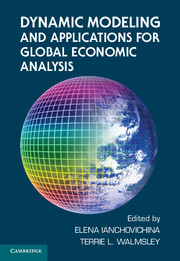Book contents
- Frontmatter
- Contents
- Contributors
- Acknowledgments
- PART I INTRODUCTION AND OVERVIEW
- PART II STRUCTURE OF THE DYNAMIC GTAP FRAMEWORK
- 2 Theoretical Structure of Dynamic GTAP
- 3 Behavioral and Entropy Parameters in the Dynamic GTAP Model
- 4 An Overview of the Dynamic GTAP Data Base: The Data Base Construction and Aggregation Programs
- 5 A Baseline Scenario for the Dynamic GTAP Model
- 6 Welfare Analysis in the Dynamic GTAP Model
- 7 Implementing the Dynamic GTAP Model in the RunDynam Software
- PART III APPLICATIONS OF DYNAMIC GTAP
- PART IV EVALUATION OF THE DYNAMIC GTAP FRAMEWORK
- Appendix: Negative Investment: Incorporating a Complementarity into the Dynamic GTAP Model
- Glossary of GDyn Notation
- Index
- References
6 - Welfare Analysis in the Dynamic GTAP Model
Published online by Cambridge University Press: 05 June 2012
- Frontmatter
- Contents
- Contributors
- Acknowledgments
- PART I INTRODUCTION AND OVERVIEW
- PART II STRUCTURE OF THE DYNAMIC GTAP FRAMEWORK
- 2 Theoretical Structure of Dynamic GTAP
- 3 Behavioral and Entropy Parameters in the Dynamic GTAP Model
- 4 An Overview of the Dynamic GTAP Data Base: The Data Base Construction and Aggregation Programs
- 5 A Baseline Scenario for the Dynamic GTAP Model
- 6 Welfare Analysis in the Dynamic GTAP Model
- 7 Implementing the Dynamic GTAP Model in the RunDynam Software
- PART III APPLICATIONS OF DYNAMIC GTAP
- PART IV EVALUATION OF THE DYNAMIC GTAP FRAMEWORK
- Appendix: Negative Investment: Incorporating a Complementarity into the Dynamic GTAP Model
- Glossary of GDyn Notation
- Index
- References
Summary
Introduction
The use of welfare measures is now commonplace in many AGE applications. The calculation and decomposition of welfare have become important parts of the analytical tools used to evaluate and/or compare the impact of policies on regions. In dynamic models, in which the importance of capital ownership features significantly, welfare measures are clearly superior to the use of real GDP as a measure of assessing the benefits of a policy. This is because GDP is defined as goods and services produced in the country, rather than as ownership of produced goods and services. However, calculating and decomposing welfare in a dynamic model are much more difficult tasks than in the traditional comparative static models.
The aim of this chapter is to develop a method for decomposing welfare in the GDyn model presented in Chapter 2. In fulfilling this aim, a number of practical problems associated with decomposing welfare in the GDyn model arise. These problems are discussed and a solution is proposed. It involves a comparative static simulation that allows us to decompose the welfare change resulting from a policy shock at any year during the simulation horizon. The method is illustrated using an example.
The Welfare Decomposition
The welfare decomposition used in the GDyn model is based on the welfare decomposition outlined in Hertel and Huff (2001) for the comparative static GTAP model. Hanslow (2000) generalized it, showing that the decomposition can be applied to other models; for example, with multiple households and/or foreign income flows resulting from foreign capital ownership, remittances, or foreign aid.
- Type
- Chapter
- Information
- Dynamic Modeling and Applications for Global Economic Analysis , pp. 158 - 172Publisher: Cambridge University PressPrint publication year: 2012



